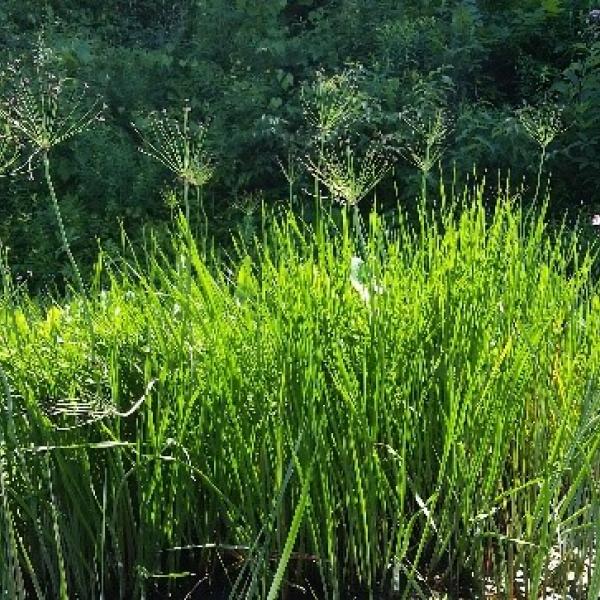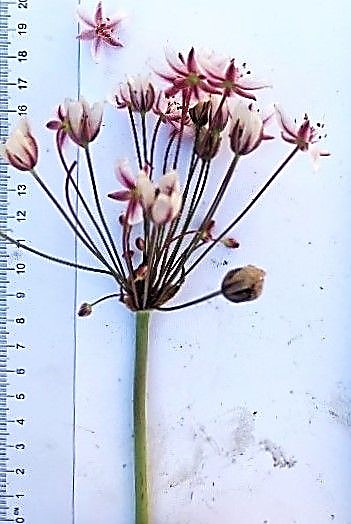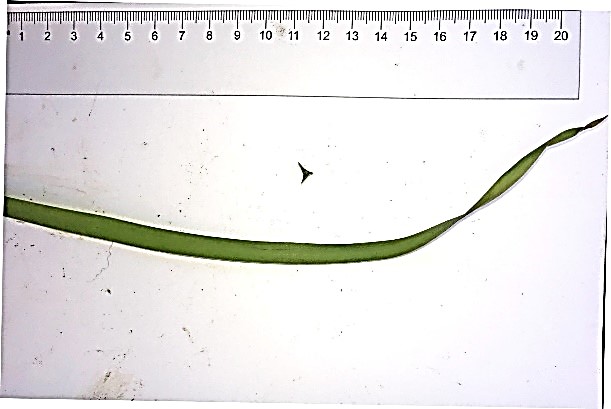
Butomus umbellatus, or flowering rush, is a non-native perennial that was introduced from Eurasia in the late 1800’s as a garden plant. Popular for its showy umbrella of petite, pink flowers, since its introduction to North America, this “garden” species has become an invasive and is listed on Vermont and many other states noxious weed lists. No longer confined to gardens, the plant can spread through a variety of means through seed dispersal and is now found throughout the Great Lakes Region. Another potential cause for its introduction may have been from ship ballast water which would support the evidence of the first observations of Butomus umbellatus along the St. Lawrence River in 1905. Increasing in frequency, this showy plant is finding its way into new environs and is commonly found within the Lake Champlain Basin.
Generally, once established in a watershed, Butomus umbellatus spreads locally by rhizomes (underground stems) and root fragmentation. Flowering rush can be can reproduce sexually via seed production, or by vegetative bulbils or fragmentation. Reports of muskrats using Butomus umbellatus for building homes also may contribute to its local spread. New populations may be introduced by continued horticultural plantings, boat traffic, and water and ice movements within a waterbody.
Butomus umbellatus is found along the water’s edge and can tolerate waters as deep or deeper than two meters, thus this species can grow in lakes, riparian zones, water courses, wetlands, and marshes. Additionally, flowering rush thrives in waterbodies with fluctuating water levels which promotes the multiplication by sprouting rhizomes. Once established, populations tend to increase and persist indefinitely.
How is Butomus umbellatus identified?
Butomus umbellatus is a moderately tall herbaceous perennial able to reach 1.5 m in height. The sword-like, smooth edged leaves sprout from basal leaves that originate from an underground rhizome. Generally, Butomus umbellatus’ characteristic growth resembles that of a bulrush with its tall, stout leaves and erect flowering stalk. Flowering rush’s emergent stems are strongly triangular or keeled, in cross section, which sets this species apart from typical bulrush’s which have rounded stems.
This species is easiest to identify when flowering. Flowers are produced only on emergent flowering stalks and are comprised of three whitish-pink petals and three sepals arranged in umbels, otherwise known as umbrella shaped clusters. Learn more about identification here.
What management options are available?
Prevention is the best approach for controlling Butomus umbellatus. In Vermont, it is illegal to transport any aquatic plant under the Vermont Nuisance Species transportation law, thus any aquatic plant debris on boats and trailers must be disposed of. Discarded material should then be placed on high ground where there is no danger of washing back into the water body.
Once flowering rush is established there are few steps that can be taken to control this species. In terms of control methods, hand digging and bottom barriers have proven to be successful against small infestations. All rhizome fragments must be removed when hand digging and repeated harvesting will likely be required. Bottom barriers also can be used to restrict growth in areas, but this serves as a preventive measure. Currently there are no herbicides that are selective for flowering rush and it is hard to eradicate with herbicides alone. Generally, herbicides are most effective on dry banks or in very shallow water, but these herbicides can be easily washed away and may require a permit. There are also no biological control methods available for flowering rush. Large stands of Butomus umbellatus become very difficult to eradicate and an ounce of prevention is worth a pound of cure.
How can you help?
If you see flowering rush, take a picture, and post it on iNaturalist and if you are able to safely dig it out, please do so. Early detection and removal of these pioneer infestations is critical in controlling Butomus umbellatus.


Citations
Cao, L., L. Berent, and A. Fusaro, 2020. Butomus umbellatus. Retrieved on 25 August 2020.
Hroudová, Z., A. Krahulcová, P. Zákravský, V. Jarolímová. 1996. The biology of Butomus umbellatus in shallow waters with fluctuating water level. Hydrobiologia 340:27—30.
Jacobs, J., J. Mangold, H. Parkinson, V. Dupuis, and P. Rice, 2011. Ecology and Management of Flowering Rush (Butomus umbellatus L.). Retrieved on 22 September 2020.
Jensen, D. 2011. Flowering rush (Butomus umbellatus). Retrieved on 25 August 2020.
Minnesota Department of Natural Resources, 2020. Flowering rush (Butomus umbellatus). Retrieved on 25 August 2020.
Tilley, D. 2012. Plant guide for hardstem bulrush (Schoenoplectus acutus). USDA-Natural Resources Conservation Service, Idaho Plant Materials Center. Aberdeen, ID. 83210.
Photo Credit
Heather Murphy, 2020 – Vermont Aquatic Invasive Species Operations Technician